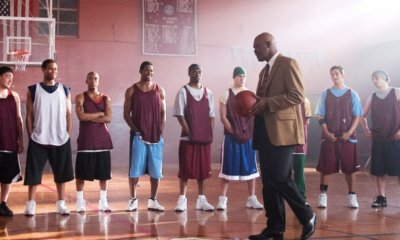Life
Question Yourself: What a Common Play in Basketball Teaches Us About Ourselves

If you’ve ever played or watched basketball, you know this play. The scramble for the loose ball. A player deflects a pass. Shawn Bradley [that lanky dude from Space Jam] is awkward, as per usual, and drops a pass thrown his way. A player dribbles the ball off of their own foot.
Two players from opposing teams scramble for it. Neither gains control of the ball yet both appear to have hit it. The trajectory of the ball is somehow altered and is sent careening out of bounds.
Neither player claims responsibility and both parties immediately launch into an over-the-top performative and surprisingly unnecessarily animated game of finger-pointing. Both players are suggesting that the other is at fault for the ball being sent out of play, each making the case for their team retaining possession.
Back when I played, there were more than a few times where I knew it was out off of me but I still plead my case. I’d wildly flail my appendages and point in the opposing team’s direction, loudly yelling about how it was off of the other player. However, maybe there’s actually something to this. Maybe we can actually learn about our own perception of the events in our lives because of a loose ball in basketball.
Are these players lying? Are they certain the ball went out off of them but pretending it didn’t to gain a competitive advantage? Or do they actually think it went out off of their opponent? Do two competitors participating in the same play experience it differently?
Much to my delight, researchers at Arizona State University who found themselves with way too much time on their hands somehow managed to get themselves paid to figure that out. Their findings were published in Science Advances.
Don’t Trust Your Perception
Ty Tang, a doctoral candidate in cognitive science, says that, in general, our subjective experience [“he touched it last!”] of an objective event [a loose ball that two players are chasing] is not trustworthy. ‘It’s very possible that people experience two different orders of events, two different experiences of reality, even though they experienced the same event.”
To test this, he ran three different experiments with ASU students. In the first, he had students sit across from one another with a divider between them. The divider had a slot for their hands and when a light flashed, each person tapped the other. They then indicated who they thought tapped first.
Most people perceived their touch as happening first. He then replaced the second human with a mechanically operated switch and got similar results. In the final experiment, they removed the element of touch and replaced it with a clicking sound. People still thought their touch happened before the click.
This bias makes sense in competitive situations. Coming back to the loose ball: it’s advantageous to believe that you touched it before your opponent indicating that they touched it last and your team should have possession. But what about outside of that?
“I have been up against tough competition all my life; I wouldn’t know how to get along without it.” – Walt Disney
What does this mean for us?
I’m still not convinced this wasn’t all just a thinly veiled excuse for a doctoral student to write a paper about basketball – but there’s interesting implications for our own understanding of reality.
Tang suggests this bias might be a result of our proclivity for attempting to predict what’s going to happen in our world and trying to build a mental model of reality before things have actually occurred.
First, we can learn to distrust our own judgments of events that have occurred. This doesn’t mean we should walk around in a constant haze of doubt, second-guessing everything that has happened to us. That wouldn’t get us anywhere, except maybe in an asylum. Instead, what we can do, is use the knowledge that our own perception is limited and biased as a launchpad for examining other ways of being in and seeing the world.
We can also entertain the idea that someone else’s perspective on an event is not only a valid interpretation but is equally as “real,” especially to them, as our own. This leads us to our second important takeaway.
“The difference between average people and achieving people is their perception of and response to failure.” – John C. Maxwell
Tang says, “Sometimes people actually do have different experiences of what happened and they’re not lying – they might have actually just experienced it that way. We can be more sensitive to other people’s perspectives. He says that “we really just want people to be more understanding of other people’s perspectives.”
These findings can facilitate a deeper understanding of our world and the perceptions that shape as well as develop a deeper empathy towards one another. Or maybe it was all just a clever ruse for a bored, overworked and underpaid grad student to write about basketball.
Tang ends his discussion with this: “We have identified what may be a principal cause of arguments in ballgames, and it’s about time.” Get it?
How do you handle conflict caused by a differing of opinions or perspectives? Share your tactics below!
Life
Imposter Syndrome Is Rooted in Your Past But Here’s How You Can Rewire It
Imposter syndrome is most prevalent in highly successful women

Imposter syndrome is “the persistent inability to believe that one’s success is deserved or has been legitimately achieved as a result of one’s own efforts or skills.” (more…)
Life
The Surprising Mental Health Tool You Probably Haven’t Tried
Through journaling, I arrived at a more balanced perspective, it reinstated my sense of gratitude and led me to accept my disability

In two particularly difficult times in my adult life, my journaling practice is helping me heal emotionally. It has been a vital tool for helping me see the bigger picture and land in a place of gratitude. (more…)
Life
How to Stop Comparing Yourself to Others and Find True Happiness
Comparison is the thief of joy; it robs us of our happiness, self-esteem, and peace of mind

In today’s hyperconnected world, it’s easier than ever to fall into the trap of comparing ourselves to others. Social media platforms like Instagram, Facebook, and LinkedIn constantly bombard us with curated highlights of other people’s lives, making it seem like everyone else is happier, more successful, and more fulfilled than we are. (more…)
Life
Harness the ‘Battery Effect’ to Transform Life’s Tensions into Your Greatest Strength
Recharge your life batteries by shifting your mindset today

I believe our life capacity is determined by the skillsets we develop on this spinning rock we call Earth. By “life capacity,” I mean our ability to embrace and sustain joy. (more…)
-

 Personal Development4 weeks ago
Personal Development4 weeks agoWant to Change the World? Start by Sharing Your Knowledge
-

 Success Advice3 weeks ago
Success Advice3 weeks agoThe One Mindset Shift That Made Me Irreplaceable At Work
-

 Scale Your Business3 weeks ago
Scale Your Business3 weeks agoWhy Smart Entrepreneurs Never Skip This One Business Expense
-

 Success Advice2 weeks ago
Success Advice2 weeks agoHow Playing by the Rules Became the Smartest Business Strategy
-

 Did You Know2 weeks ago
Did You Know2 weeks ago7 Surprising Life Lessons Video Games Taught Me That School Never Did
-

 Success Advice2 weeks ago
Success Advice2 weeks agoHow to Build Trust, Kill Micromanagement, and Lead a Team That Thrives
-

 Scale Your Business2 weeks ago
Scale Your Business2 weeks agoHow to Build a Workplace People Actually Want to Show Up To
-

 Success Advice1 week ago
Success Advice1 week agoSuccess Isn’t Sexy: 5 Daily Habits That Actually Work




























1 Comment